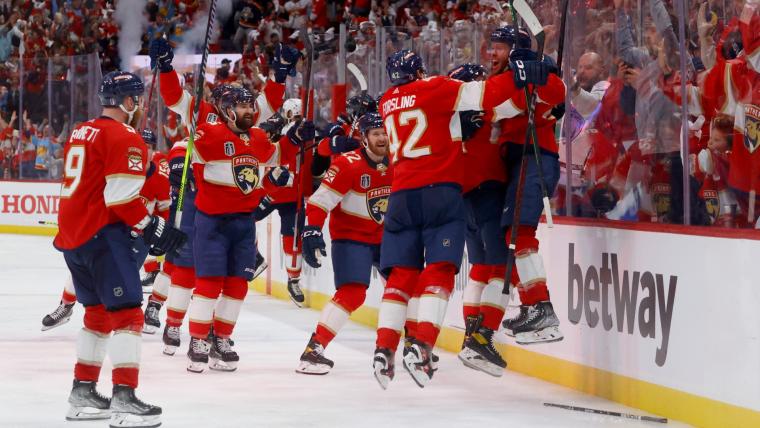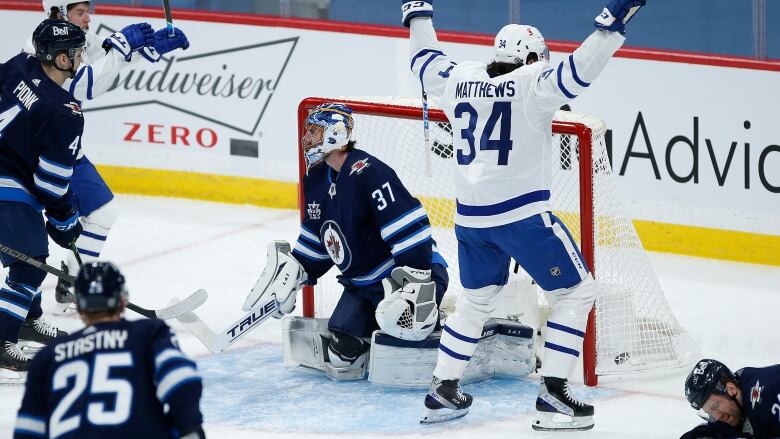What Does OTL Mean in Hockey? Overtime in hockey is like sudden death – the first goal ends the game! The winning team gets a win while the losing team earns a point for an OTL.
But what’s that OTL in hockey lingo?
OTL means overtime loss, and it’s a stat tracked in NHL standings. Since 2005-06, when a game hits overtime, both teams snag at least one point. The victor claims 2 points, and the loser gets 1 for the OTL.
In hockey, teams rack up points based on game outcomes each regular season. Points earned decide who makes the playoffs.
Games going into overtime are “three-point games.” Bag 2 for an overtime win, and 1 for an overtime loss! 🏒
What Is Overtime in Hockey?

Overtime in hockey is an additional period that takes place when two teams are tied after the standard 60 minutes of play. This extra time, known as overtime, is executed as a sudden death period where the team that scores first clinches victory.
During the regular season, the overtime period spans 5 minutes and features a 3-on-3 format, intensifying the fast-paced action. If the 5-minute overtime concludes without any goals, the game proceeds to a shootout. In a shootout, both teams take turns attempting penalty shots until a decisive winner emerges.
In the playoffs, the rules for overtime differ from the regular season. Playoff overtime extends to 20 minutes, mirroring the standard 5-on-5 play, akin to any regular period of the game. Notably, in playoff scenarios, the overtime session persists until a team scores, eliminating the possibility of a shootout and adding to the suspense and excitement of the postseason games.
How Many Points Is an OTL in Hockey?

During the regular season in ice hockey, when a game extends into overtime, both teams are awarded 1 point in the standings. If the game concludes with a winner, whether in overtime or a shootout, the victorious team earns 2 points. This win is reflected in the team’s overall standing. In case of an overtime victory, the team’s Regulation and Overtime Win (ROW) total increases, while a shootout win contributes to the Shootout Win (SOW) statistic.
On the other hand, the losing team in a regular season overtime retains 1 point in the standings and is marked with an Overtime Loss (OTL). Transitioning to playoff scenarios, where overtimes can be continuous, the defeated team still receives an OTL designation. However, unlike the regular season, no points are awarded in playoffs; only wins and losses are recorded. Players often find playoff OTLs particularly disheartening, having played over 60 intense minutes and ending up with no tangible reward for their hard work.
What Is an SOL in Hockey?
In hockey, when the overtime period ends during the regular season, the game transitions into a shootout. A shootout, a thrilling phase for fans and players alike, unfolds as teams select skaters to take turns attempting penalty shots against the opposing goalie until a decisive victor emerges. The tension mounts as each shot could shift the game’s fate. The team that falls short in the shootout is attributed an SOL, signifying a shootout loss in the NHL standings. Despite the loss, they secure one point for the effort of extending the game to overtime, showcasing their competitive spirit.
Conversely, the victorious team in the shootout earns an SOW, denoting a shootout win, and garners two valuable points for triumphing in this high-stakes showdown. The strategy, skill, and nerve displayed during shootouts add an electrifying element to the game, making each decisive moment a test of talent and composure.
NHL Point System
The NHL standings are determined by a point system unique to hockey. In most sports, such as football, baseball, and basketball, standings are typically based solely on wins and losses. However, hockey introduces a different dynamic. Interestingly, in hockey, even losing teams can see an improvement in their rank within the standings.

When it comes to the NHL, the winning team is awarded two points, regardless of whether the victory is secured in regulation time, overtime, or in a shootout. Throughout the course of a season, a team can potentially accumulate up to 164 points (calculated by 82 games multiplied by 2 points for each win). Despite this theoretical possibility, it is extremely unlikely to occur. Teams generally aim to reach the 100-point milestone during a season, a benchmark that often secures a playoff spot.
In the event of a loss in regulation time, the team is granted zero points in the standings. Conversely, if a game ends in a tie after regulation, both competing teams automatically receive 1 point each. The team that prevails in overtime or a shootout earns an additional point (totaling 2 points), while the losing team settles for a single point.
While a shootout victory is rewarded with 2 points just like any other win, it is important to note that not all wins hold the same weight in the NHL. This distinction arises due to the league’s tie-breaking criteria, which prioritizes teams with more regulation wins, followed by those with more regulation and overtime wins.
Therefore, although each win contributes 2 points to a team’s standing, the significance lies in the hierarchy of win types: regulation wins are paramount, followed by overtime wins, and ultimately shootout wins from a tiebreaker perspective.
How Do You Read the NHL Standings?
NHL standings can be complex to decipher due to the multitude of statistics tracked for each team. Fundamentally, the NHL standings offer readers a glimpse into which teams are presently poised for a playoff spot (and which ones are not), along with how teams measure up statistically against all other teams in the league.
While an array of stats is monitored in the NHL standings, the pivotal metrics are PTS (Points) and P% (Points Percentage). PTS play a significant role in determining playoff contenders, as the more points a team accumulates, the greater their likelihood of securing a playoff berth.

It’s worth noting that points alone may not always guarantee a playoff berth. Sixteen teams qualify for the playoffs annually, with eight hailing from the Western Conference and eight from the Eastern Conference.
Each conference is divided into two divisions, and the top three teams in each division clinch a playoff spot. The remaining four spots are designated as “wildcard” entries and are awarded to the two teams in each conference with the highest points total that did not finish in the top three of their respective division.
This setup allows for the intriguing possibility of a team earning a playoff berth over another with more points by excelling within their division.
P% serves as a metric indicating a team’s performance relative to others when the number of games played is not uniform. Represented as a decimal, P% showcases the points a team has earned in comparison to the maximum points achievable if they emerged victorious in all their matches.
For instance, if a team wins three out of four games at the beginning of a season, their P% would be .750, signifying they have secured 75% of the potential points up to that juncture in the season.
Additional noteworthy statistics encompass GF (Goals For), GA (Goals Against), and DIFF (goal differential (GF – GA)). Performance indicators reflecting recent team form include L10 (record over a team’s preceding 10 games) and STRK (current winning or losing streak).
What Does TP Mean in Hockey?
TP in hockey stands for Total Points. In the past, TP served as a significant team stat category used to monitor the total points accumulated by a team at various stages. This metric has undergone a transition in the NHL standings, now represented as PTS, which denotes the points earned by each team throughout the season.
What Does GF Mean in Hockey?
In the NHL standings, GF (Goals For) signifies the total number of goals a team has successfully netted during a specific point in the ongoing season. Teams with a higher tally in goals tend to secure a better position in the standings, indicating a correlation between scoring prowess and success in hockey games.
In assessing team performance, it’s crucial to consider GF in conjunction with GA (Goals Against). Focusing solely on GF can be misleading, as a team’s victory is contingent not only on its scoring ability but also on its defensive competence in preventing goals.
For a comprehensive evaluation of team performance in terms of goals, observers often turn to the stat category of DIFF (Goal Differential). This metric, calculated by subtracting GA from GF, offers a nuanced perspective by presenting the goal difference as a positive or negative figure. Teams boasting a superior goal differential typically occupy higher ranks in the standings, reflecting a balanced approach to offensive and defensive strategies.
What Does STRK Mean in Hockey?

STRK, short for streak, is a significant indicator in the NHL standings, revealing the current winning or losing streak for a team at a specific moment. This notation is commonly represented by letters: W for win, L for loss, and OT for overtime or shootout loss, followed by the consecutive number of games with the same outcome.
It serves as a valuable tool in assessing a team’s performance in short intervals. For instance, a STRK of W5 implies that the team has emerged victorious in their last five games, showcasing a commendable winning streak.
What Does ROW Mean in Hockey?
In the NHL standings, ROW stands for Regulation and Overtime Wins. It is a key statistic that not only reflects the number of games a team has won in regulation or overtime but also indicates their ability to secure victories in crucial game scenarios. When teams are tied in points, ROW serves as the second tiebreaker after RW (Regulation Wins) to determine their standings, highlighting the significance of winning games decisively within regular gameplay time or during overtime periods.
Furthermore, the importance of a regulation win is emphasized in the playoff race, as it carries more weight than an overtime or shootout win. This distinction underscores the strategic value of securing wins in regulation, which can have a significant impact on a team’s playoff positioning and overall success in the league.
FAQ
What Is the Current NHL Record for Team Points in a Season?
Did you know that the 1976-77 Montreal Canadiens hold the record for the most team points in a season with 132 points? Pretty impressive, right? They achieved this when teams played 80 games, not the current 82. Their .825 P% meant they earned 82.5% of the maximum points that season and unsurprisingly, they won the Stanley Cup!
On the flip side, the 1974-75 Washington Capitals had the fewest team points in a season with only 21 points in their debut NHL season. Quite a contrast to the Canadiens, huh? Their P% was a mere .121, showing they only earned 12.1% of the maximum points possible.
What Is the Current NHL Record for Points Percentage in a Season?
The 1929-30 Boston Bruins hold the record for the highest Points Percentage (P%) in a single season, achieving an impressive .875 or 87.5% of the maximum possible points. During that remarkable season, the Bruins boasted an outstanding record of 38 wins, 5 losses, and 1 tie, accumulating a total of 77 points. Despite their exceptional regular-season performance, the Bruins faced a disappointing defeat in the Stanley Cup Final that year against the Montreal Canadiens, marking a bittersweet conclusion to their stellar campaign.
What Team Has the Record for Most Season Overtime Losses in History?
Currently, in the history of the NHL, there are four teams that share the record for the most overtime losses in a single season. The Philadelphia Flyers in the 2014-15 season, the New Jersey Devils in the 2013-14 season, the Florida Panthers in the 2011-12 season, and the Tampa Bay Lightning in the 2008-09 season all experienced the same fate, each accumulating 18 overtime losses during their respective seasons. This stat highlights the unpredictability and competitiveness of NHL games, where every point matters in the quest for victory.
What Team Has the Best Shootout Record in History?
The New York Islanders dominate the NHL history books with a whopping 86 Shootout wins, while the Colorado Avalanche holds the crown for the best Shootout Win % at an impressive .635!
What Is the Longest Winning Streak in NHL History?
During the 1992-93 season, the Pittsburgh Penguins crushed it by winning 17 games in a row from 3/9/1993 to 4/10/1993. And can you believe it, the 1979-80 Philadelphia Flyers went on a crazy streak of 35 straight games earning a point!
What Is the President’s Trophy in Hockey?
The President’s Trophy goes to the team with the most points in the regular season. Surprisingly, despite this, the winner has only clinched the Stanley Cup eight times since it started back in 1985-86. The latest was in 2012-13, with the Chicago Blackhawks triumphing over the Boston Bruins in six games.
